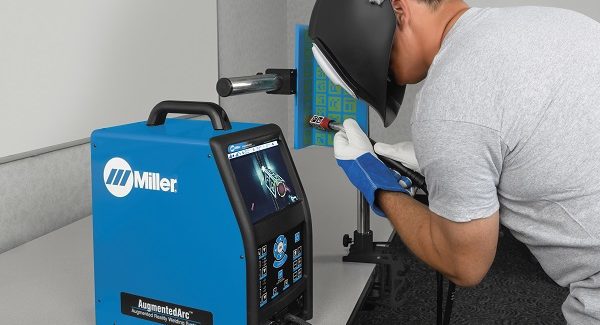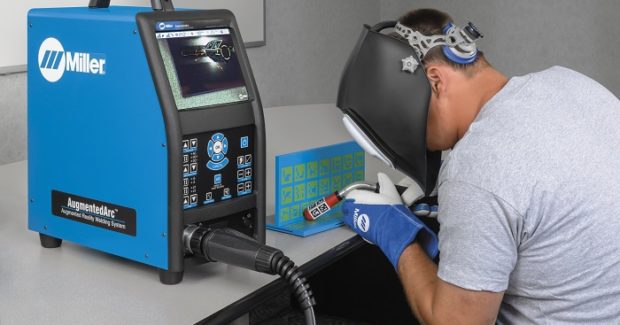Augmented Reality: Finding a Better Way to Screen and Train Welding Applicants
Shops can now create a welding lab experience without a lab by using new technology that simulates various welding processes and blends real-world and computer-generated images into an augmented reality environment for a realistic welding simulation that closely resembles live arc welding – and provides them with an objective means of measuring the skills of each applicant.
Posted: April 17, 2017
Screening job applicants can be a costly and time-consuming task for fabrication shops and welding operations, one that is becoming increasingly important as they deal with the industry’s growing welding operator shortage. A job shop with one welding position may get 100 applicants, all with a wide range of skills except the adequate welding skills required for the job. What is the most efficient and effective way to find the most skilled welders, or the fastest learners, from this pool of workers? While the screening process varies by company, this question was often answered by testing each applicant using actual welding on some level. This requires the use of welding resources such as coupons, gas, wire and time for someone to watch and evaluate the applicant’s weld.
With the welding operator shortage making it a priority to find better and faster training solutions, welding equipment manufacturers are developing technologies that help save shops time and money in the screening and training of welders.
WELDING SIMULATION SOLUTIONS
Virtual reality and welding simulation systems provide an answer that offers cost savings and efficiency in screening and training. For example, one new technology that is now available on the market is our AugmentedArc™ Augmented Reality Welding System that simulates GMAW, FCAW, GTAW and SMAW processes, blending real-world and computer-generated images into an augmented reality environment for a realistic welding simulation that closely resembles live arc welding. The technology works like this: Students use real 3D objects and see them overlaid with computer-generated images. They wear a specially designed helmet that uses a camera and sensor to send video and positioning data to the system computer, which processes the data and then creates a realistic welding simulation and graphic information based on the user’s actions. That information is then sent to a heads-up display and speakers inside the helmet, delivering immediate visual feedback on the user’s performance.
To the user, this looks and sounds like actual welding, complete with metal workpieces, welding arcs and weld beads. However, because they are not consuming coupons, wire or gas, it saves the company money and resources. It’s like a welding lab experience without the lab. Once the welding exercise is complete, an analysis screen provides feedback on the user’s performance in the form of scores and graphs. You can also play back the weld that was made – and watch it from any angle – to see how that weld was completed, with the graphs superimposed adjacent to the length of the weld. This provides the company with an objective means of measuring the skills of each applicant, allowing them to gauge a candidate’s skills on a determined scoring process for that organization.
FASTER SCREENING AND TRAINING
There are numerous benefits to using this type of simulation technology for applicant screening and welder training:
- Minimize material cost: Because simulation technology provides a welding lab experience without the actual lab, there is less waste of resources, saving companies money.
- Optimize instructor efficiency: As there is more demand for welding operators and screening and training classrooms potentially become larger, instructors and trainers get pulled in more directions. Technology can be a classroom assistant, allowing trainers to be more efficient and spend quality one-on-one time more often with learners.
- Deliver real-time feedback: By providing immediate feedback to users, simulation technology quickly helps to correct errors, reinforce proper technique and accelerate skill advancement prior to actual live arc welding in a lab.
- Reduce overall training time: Compared to traditional methods, simulation technology helps to reduce the amount of time needed to teach users welding techniques and methods.
- Build a larger, more-skilled workforce: Traditional classrooms may not always capture the imagination of students who grew up with smart technology. Innovative technology like this can help companies create awareness of opportunities and attract computer-savvy applicants to welding programs.
GAIN AN ADVANTAGE WITH TECHNOLOGY
Our AugmentedArc system bridges the gap between virtual reality and actual welding. This technology provides close simulation to live arc welding without utilizing costly resources. There are other technologies available on the market that can help companies transform their screening, recruiting and training processes for welding, making them more effective and efficient while saving time, money and resources. Embracing these types of innovative technologies also provides shops with more opportunities to introduce welding to a new generation of potential welders.

















